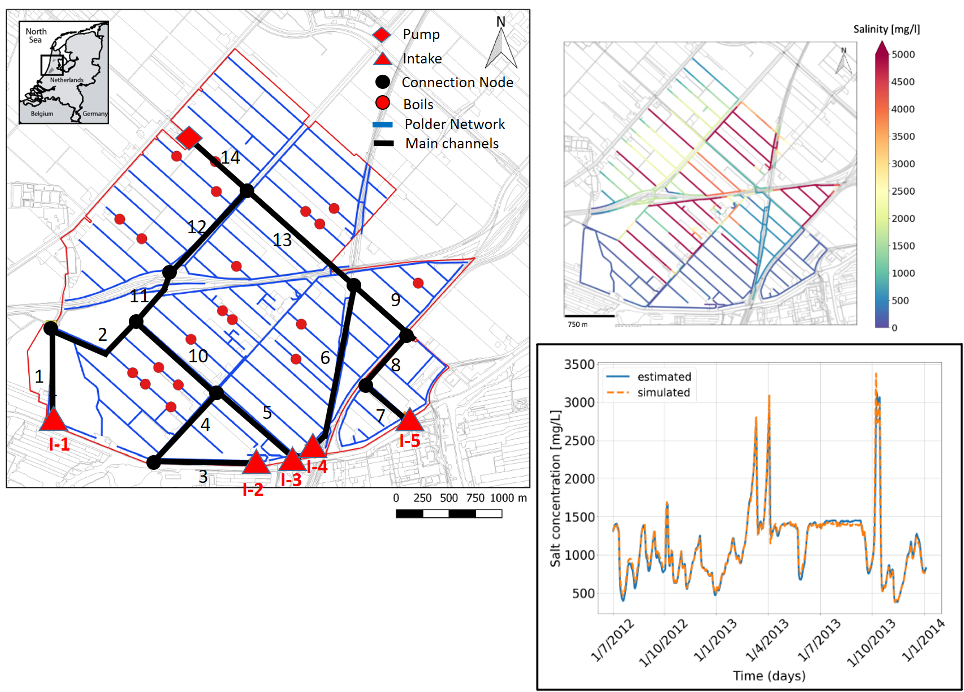Operational management of regional salt-fresh water resources
As participants of the WaterNexus consortium, we explore Model Predictive Control of for agricultural polder networks to manage Water Level, Salinity and Fresh Water use. Land subsidence, climate change induced decrease in precipitation and sea level rise are expected to accelerate salinization of groundwater and surface water systems. To counteract surface water salinization, fresh- water diverted from rivers is used for flushing the canals and ditches in coastal areas. Sustaining freshwater-dependent agriculture in such areas will entail an increased demand for flushing, while the demand of a better water quality will tend to increase. On the other hand, freshwater usage is not explicitly considered for polder operation and results in excessive use. Decreasing the amount of freshwater usage for polder flushing can create additional supply opportunities for industrial users, drinking water com- panies or other irrigation systems. To meet the increasing demand for flushing due to expected increase of salinization while the freshwater availability is decreasing, new operational designs are required for polders that will use the available freshwater resources efficiently. Efficient water management in polders aims to regulate water levels, salinity levels and the water usage by manipulating the intake and pump flows.
Boran Aydin (successfully defended PhD in August 2020 at TU Delft)
During 2016-2020, adavanced Model Predictive Control (MPC) approaches were developed to optimally control polder flushing for irrigation water quality and water level control. With explicit consideration of constraints and multiple objectives (water quality, freshwater use, flooding ), fast control algorithms are developed for real-time control. To enable feedback control based on measurements, new algortihms were developed for optimal sensor placement to estimate salinity in polder networks. These methods were developed using data from the Lissertocht catchment in Haarlemmermeer, Netherlands. Distributed temperature sensing (DTS) measurements, electrical conductivity (EC) measurements, and hydrodynamic and salt transport models were used together to derive and validated the new approaches.
 State estimation and model predictive control for salinity management in irrigation polders
State estimation and model predictive control for salinity management in irrigation polders
Project outputs
Aydin, Boran Ekin, Gualbert HP Oude Essink, Joost R. Delsman, Nick van de Giesen, and Edo Abraham. “Nonlinear model predictive control of salinity and water level in polder networks: Case study of Lissertocht catchment.” Agricultural Water Management 264 (2022): 107502.
Aydin B, Tian X, Delsman J, Oude Essink GualbertHP, Rutten M and Abraham E (2019), “Optimal salinity and water level control of water courses using Model Predictive Control”, Environmental Modelling & Software., 2, 2019. Vol. 112, pp. 36-45. Elsevier.
Aydin BE, Hagedooren H and Abraham E (2019), “A Heuristic Approach to Effective Sensor Placement for Salinity State Reconstruction in a Low-Lying Polder”, In EGU General Assembly Conference Abstracts.
Aydin BoranEkin, Hagedooren H, Rutten MartineM, Delsman J, Essink GualbertHPOude, van de Giesen N and Abraham E (2019), “A greedy algorithm for optimal sensor placement to estimate salinity in polder networks”, Water. Vol. 11(5) Multidisciplinary Digital Publishing Institute (MDPI).
Aydin B, Rutten M and Abraham E (2018), “Model Predictive Control of Salinity and Water Level in a Hypothetical Polder Ditch: Is it Possible to Use the Discretized Linearized Physical Equations for Optimization”, In EPiC Series in Engineering., 9, 2018. Vol. 3, pp. 117-122. EasyChair.
Aydin B, Rutten M, Abraham E, Oude Essink G and Delsman J (2017), “Model Predictive Control of Salinity in a Polder Ditch under High Saline Groundwater Exfiltration Conditions: A Test Case”, In 20h World Congress of the International Federation of Automatic Control (IFAC), 2017. Netherlands Vol. 50(1), pp. 3160-3164. Elsevier.
Ekin Aydin B, Rutten M, Oude Essink GH, Delsman J and Abraham E (2017), “Smart Salinity Management in Low-lying Deltaic Areas: A Model Predictive Control Scheme Applied to a Test Canal”, In EGU General Assembly Conference Abstracts.
For more details please also refer to Publications.
